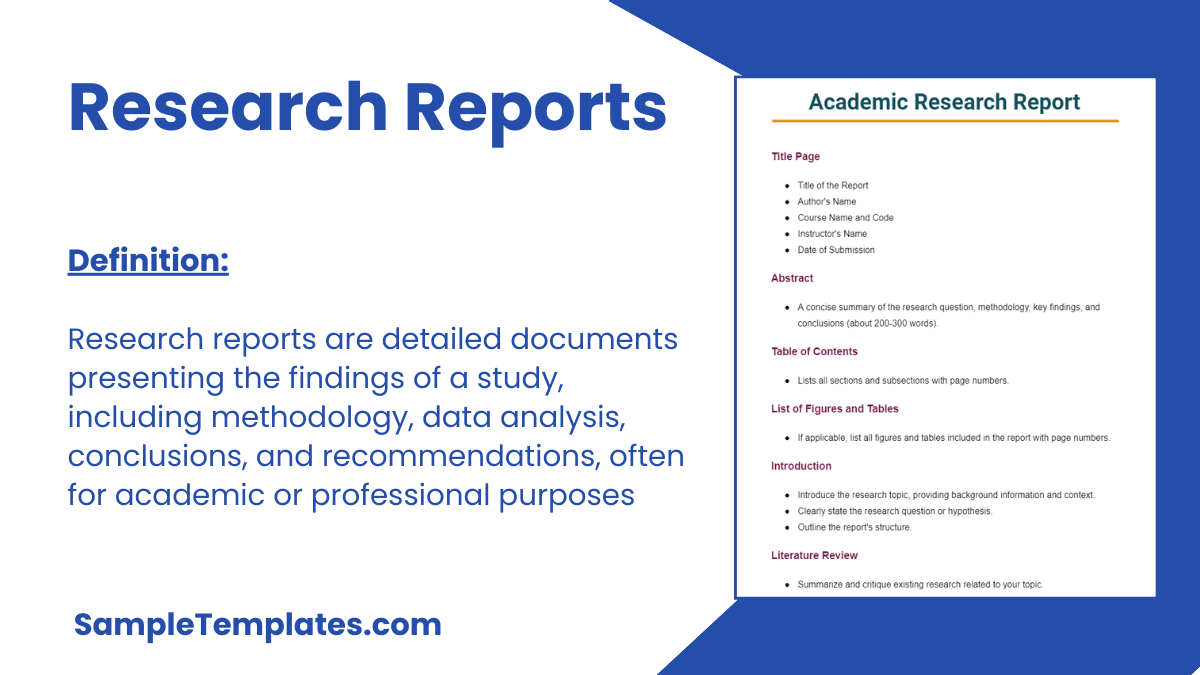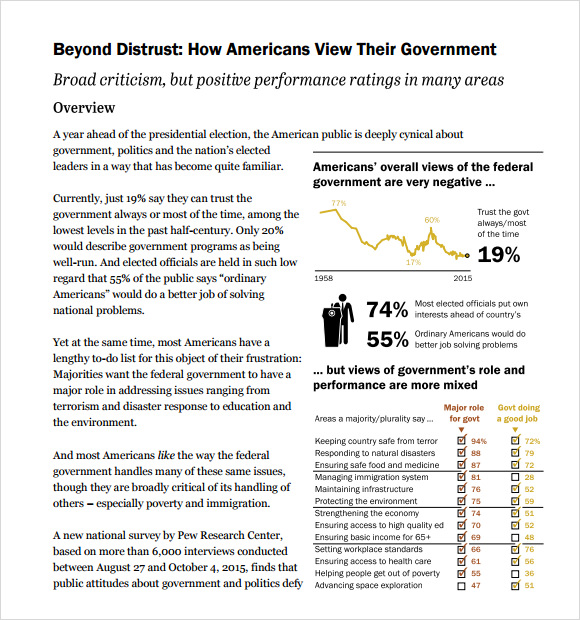People that are engage in the field of academic or in study can look at research report where they can show the people the end result of a particular research for the greater benefit of a person’s life and to add new information in the academic world. This Summary Reports is designed to show the public the result of a lifelong study in a concise manner but can be comprehended easily by anyone who reads it.
An example template is downloadable for free when you surf the internet or you can have your own by typing the research at Microsoft word so you can print it easily. Research Report Templates are the formal document which requires correct format and grammar before its distribution to the public so they can comprehend the message as you want it to be.

Download Research Reports Bundle
Research Report for Students
Title of the Research Report
Subtitle (if applicable)
Author(s):
Name of the Student(s)
Department, University
Email Address(es)
Supervisor:
Name of the Supervisor
Department, University
Email Address
Date of Submission:
[Day Month Year]
Abstract
A concise summary of the research, including the purpose, methodology, main findings, and conclusions.
Table of Contents
I. Introduction
II. Literature Review
III. Methodology
IV. Results
V. Discussion
VI. Conclusion and Recommendations
VII. References
VIII. Appendices
I. Introduction
- Background of the study
- Research objectives/questions
- Significance of the research
II. Literature Review
- Overview of existing research related to the topic
- Identification of gaps in the literature
III. Methodology
- Description of the research design
- Data collection methods
- Data analysis procedures
IV. Results
- Presentation of findings (use charts, graphs, and tables where applicable)
V. Discussion
- Interpretation of the results
- Comparison with previous studies
- Implications of the findings
VI. Conclusion and Recommendations
- Summary of key findings
- Limitations of the study
- Suggestions for future research
- Practical recommendations (if applicable)
VII. References
List all sources cited in the report following the required citation style (APA, MLA, Chicago, etc.).
VIII. Appendices
Include supplementary material such as raw data, detailed tables, questionnaires, etc.

Academic Research Report
Title Page
- Title of the Report
- Author’s Name
- Course Name and Code
- Instructor’s Name
- Date of Submission
Abstract
- A concise summary of the research question, methodology, key findings, and conclusions (about 200-300 words).
Table of Contents
- Lists all sections and subsections with page numbers.
List of Figures and Tables
- If applicable, list all figures and tables included in the report with page numbers.
Introduction
- Introduce the research topic, providing background information and context.
- Clearly state the research question or hypothesis.
- Outline the report’s structure.
Literature Review
- Summarize and critique existing research related to your topic.
- Identify gaps in the current knowledge that your research aims to fill.
Methodology
- Describe the research design and methods used for data collection and analysis.
- Include details on participants, instruments, procedures, and data processing.
Results
- Present the findings of your research without interpretation.
- Use charts, graphs, and tables to illustrate data where appropriate.
Discussion
- Interpret the results, linking them to your research question and the literature review.
- Discuss the implications of your findings and any limitations of your study.
Conclusion
- Summarize the key findings and their relevance.
- Suggest areas for future research.
References
- List all sources cited in your report in the appropriate citation style (APA, MLA, Chicago, etc.).
Appendices
- Include any additional materials (e.g., raw data, detailed analyses, questionnaires) that are relevant to the report but too voluminous for the main body.
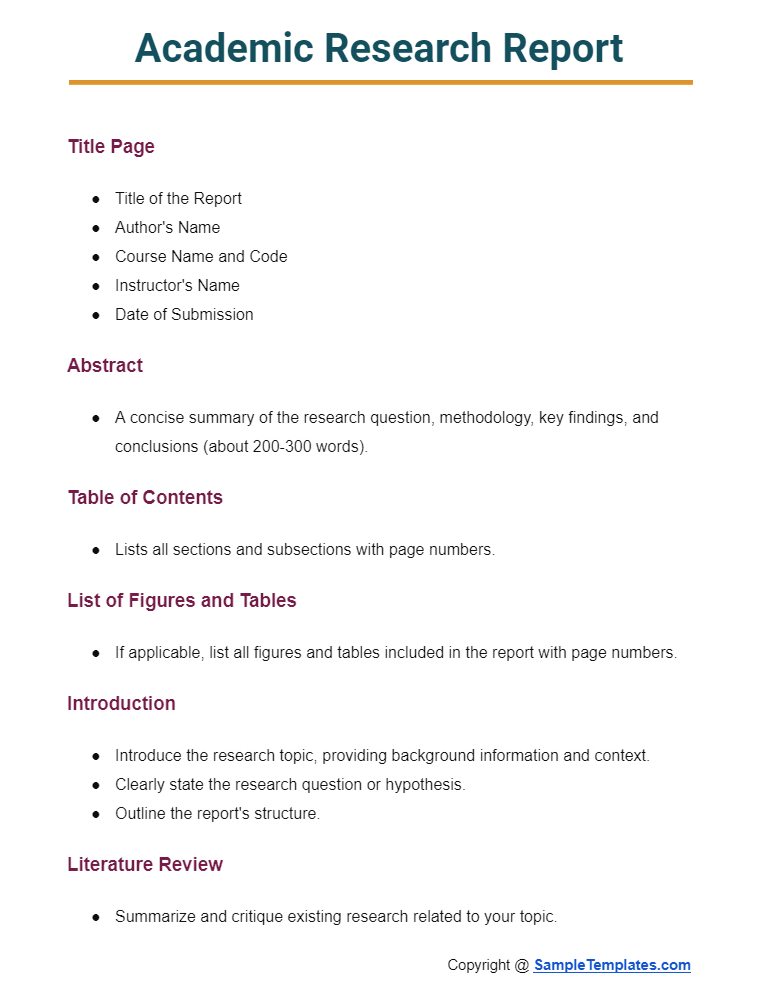
Final Research Report
Title Page
- Title of the Research
- Author(s)
- Affiliation(s)
- Date
Abstract
- A concise summary of the entire research, including the purpose, methodology, key findings, and conclusions (150-250 words).
Table of Contents
- Lists the main sections and their page numbers for easy navigation.
List of Figures and Tables
- Itemizes all figures and tables included in the report with page numbers.
Introduction
- Introduces the research topic, states the research problem, and outlines the objectives.
- Presents the background and significance of the study.
- Specifies the research questions or hypotheses.
Literature Review
- Reviews relevant existing research and theoretical frameworks.
- Establishes the foundation for the research and highlights gaps the study aims to fill.
Methodology
- Describes the research design, data collection methods, and analysis procedures.
- Details the sample selection, instruments used, and any limitations of the study.
Results (or Findings)
- Presents the data collected in an organized manner, using tables, graphs, and descriptive text.
- Summarizes the findings without interpretation.
Discussion
- Interprets the results, linking them back to the research questions and existing literature.
- Discusses the implications of the findings and any unexpected results.
- Addresses the limitations of the study and suggests areas for future research.
Conclusion
- Summarizes the key findings and their relevance.
- Restates the significance of the study and its contributions to the field.
Recommendations (if applicable)
- Provides suggestions based on the research findings for practical actions, policy changes, or further research.
References
- Lists all sources cited in the research report following the appropriate academic style (APA, MLA, Chicago, etc.).
Appendices (if necessary)
- Includes additional materials like raw data, detailed analyses, questionnaires, or maps.
Acknowledgments (optional)
- Thanks individuals, organizations, or institutions that contributed to the research.
Formatting Tips:
- Ensure consistency in headings, subheadings, and text formatting throughout the document.
- Use clear and concise language, avoiding jargon where possible.
- Proofread for spelling, grammar, and punctuation errors.
- Adhere to the citation style and formatting guidelines specified by your institution or publication.
This structure provides a comprehensive overview for writing a final research report, ensuring that all critical aspects of the research are communicated effectively.
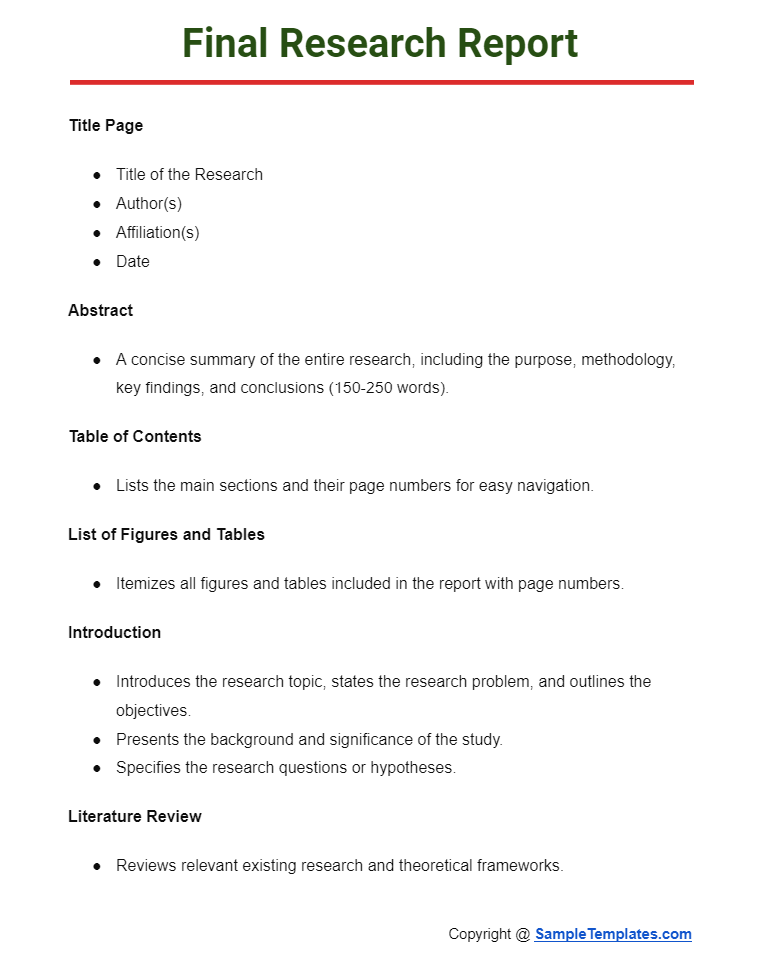
Browse More Templates On Research Report
Research Report Template
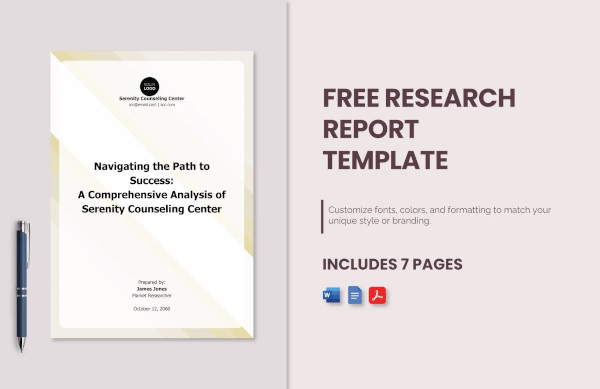
Product Research Report Template
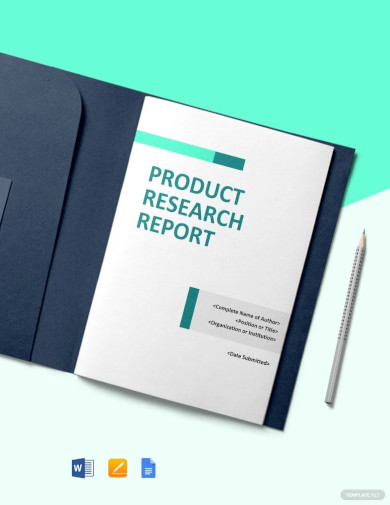
Research Paper Report Template

Tips for Writing Research Reports
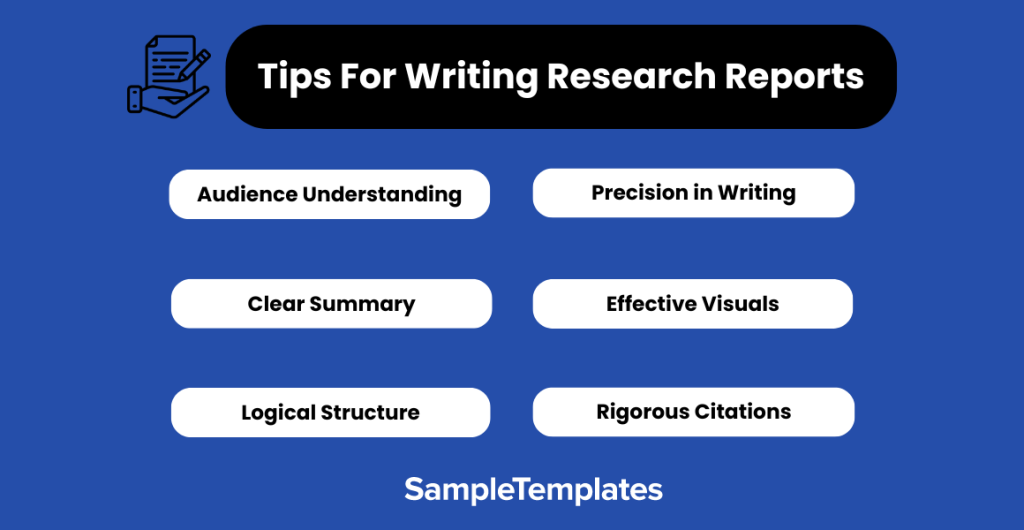
- Understand Your Audience: Tailor the language, depth of detail, and complexity of your report to meet the needs and understanding level of your audience. Whether it’s for academic peers, industry professionals, or the general public, ensure the content is accessible and relevant.
- Start with a Clear Abstract: Provide a concise and informative abstract that summarizes the key points of your research, including the problem, methodology, results, and conclusions. This helps readers quickly understand the essence of your report.
- Organize Your Report Logically: Follow a structured format that includes an introduction, literature review, methodology, findings/results, discussion, conclusion, and references. A logical flow helps readers follow your research process and findings.
- Be Precise and Concise: Use clear and direct language to convey your research. Avoid unnecessary jargon and verbosity. Make every word count by being as concise as possible without omitting crucial information.
- Use Visuals Effectively: Incorporate charts, graphs, tables, and figures to illustrate key findings and support your analysis. Visuals can help clarify complex data and make your report more engaging.
- Cite Sources Rigorously: Accurately cite all sources of information, data, and literature you’ve used in your research. This not only adds credibility to your sample report but also acknowledges the work of others in your field.
- Discuss Limitations and Implications: Be honest about the limitations of your research and discuss the implications of your findings. This demonstrates your critical thinking and understanding of the research context.
- Proofread and Edit: Thoroughly proofread your report for spelling, grammar, and punctuation errors. Consider having a peer or mentor review your work for clarity and coherence.
- Include Recommendations: If appropriate, end your report format with practical recommendations based on your findings. This can add value to your research by suggesting future directions or actions.
- Stay Ethical: Ensure your research and reporting practices are ethical. Respect privacy, obtain necessary permissions, and report data and findings truthfully.
Following these tips can enhance the quality of your research report, making it informative, credible, and impactful.
Research Report Format
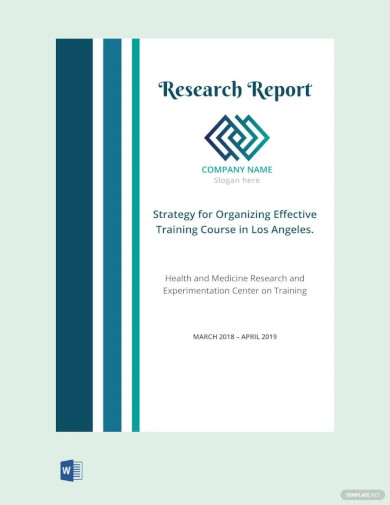
Business Research Report Template
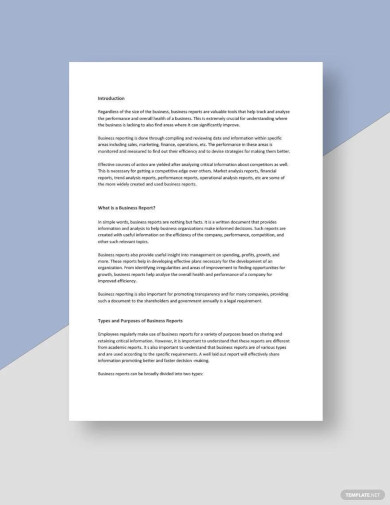
What Is a Research Report?
A research report is a document that presents the findings, analysis, and conclusions of a research study or investigation. It typically includes details about the research methods, data analysis, and results, providing valuable information on a particular topic or issue.
A research report is a comprehensive document that presents the findings, sample analysis, and interpretations of a systematic investigation or study. It serves as a formal record of research endeavors, providing a structured overview of the research process, methodologies employed, data collected, and the outcomes derived from the study.
Structure of a Research Report:
- Title Page:
- Includes the title of the report, the names of the authors, their affiliations, and the date of publication.
- Abstract:
- Offers a concise summary of the research, highlighting the purpose, methods, results, and conclusions.
- Introduction:
- Sets the stage for the research, outlining the background, objectives, and the research question or hypothesis.
- Literature Review:
- Surveys existing literature relevant to the research topic, providing context and justifying the study.
- Methodology:
- Describes the research design review, methods of data collection, and statistical or analytical techniques used.
- Results:
- Presents the raw data, often using tables, sample graphs, or charts for clarity, without interpretation.
- Discussion:
- Interprets the results, relates them to the research question, and discusses their implications. Compares findings with existing literature.
- Conclusion:
- Summarizes the key findings, reaffirms the research’s significance, and suggests avenues for future research.
- Recommendations:
- Proposes practical suggestions based on the study’s outcomes.
- References:
- Lists all sources cited in the report, following a specific citation style (APA, MLA, Chicago, etc.).
- Appendices:
- Includes supplementary materials such as raw data, questionnaires, or additional details that support the main text.
Key Components of a Research Report:
- Objectivity: A research report should maintain a neutral and objective tone, avoiding biases and subjective interpretations.
- Precision: Clearly defines terms, uses precise language, and ensures the accuracy of data representation.
- Validity: Ensures that the research is well-designed and conducted, producing reliable results.
- Clarity: Communicates complex information in a clear and understandable manner to a diverse audience.
- Ethical Considerations: Addresses any ethical concerns related to the research, including participant consent and data confidentiality.
Importance of Research Reports:
- Communication: Conveys research findings to the academic community and beyond.
- Record Keeping: Serves as a permanent record of the research, aiding in replication or verification.
- Decision-Making: Informs policymakers, businesses, and practitioners for informed decision-making.
- Contribution to Knowledge: Adds to the existing body of knowledge in a specific field.
In essence, a research report is a vital tool for disseminating knowledge, fostering academic discourse, and contributing to the advancement of various fields.
Research Report in PDF
Here is a great template for writing a report on any kind of research. Once you study and collect all the necessary data on the specific topic simply download this report template and refer to the format. Write as per the format in the template.
Types of Research Report?
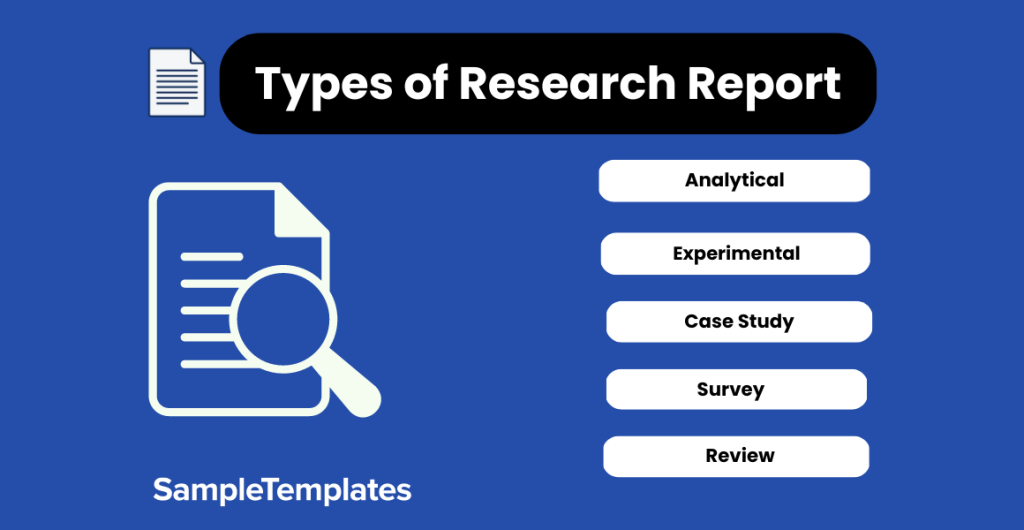
- Descriptive Research Report: Focuses on providing a detailed description of a subject, without attempting to establish causal relationships.
- Analytical Research Report: Analyzes and interprets research findings to draw conclusions and make recommendations.
- Experimental Research Report: Presents the methods, results, and analysis of controlled experiments.
- Case Study Report: Examines in-depth the details of a particular case or situation, often in real-world contexts.
- Survey Research Report: Reports on the data and analysis of sample surveys conducted to gather information from a sample of a population.
- Review Research Report: Summarizes and evaluates existing research and literature on a specific topic, providing a comprehensive overview.
What are the Key Findings of your Research Report?
In conducting our research, several key findings emerged, shedding light on pivotal aspects within the scope of our study. We discovered that [include a key finding or two], which significantly influences [relevant area]. Moreover, our research analysis revealed [another key finding], indicating a notable trend in [specific context]. Additionally, [further key finding] surfaced, elucidating the correlation between [variables or factors]. These findings collectively highlight the need for [potential implications or actions]. Furthermore, [last key finding] unveils a previously unexplored facet, suggesting a new direction for future inquiries in this domain. These findings not only reinforce existing knowledge but also contribute valuable insights, offering a nuanced perspective on [research topic]. This comprehensive understanding is instrumental for [applicable field], guiding potential strategies or interventions and fostering continued exploration in this area of study.
Undergraduate Research Report Template

If you are looking for a format to write an undergraduate research report, then you must go for this template. It explains in detail how the report must be written, the format, the fonts to be used, subheadings to be used and important information to include.
Research Report Example

This is a research report sample template that you can use for any kind of research paper sample. You need not search for different templates from the Internet. Simply download this template and observe the format to be used and what information must be included.
What is the Purpose of this Research Report?
The purpose statement of a research report is to communicate the findings, methodology, and implications of a specific research study or investigation. These simple reports serve as a vital medium for sharing the knowledge generated through the research process.
- Information Dissemination: Research reports inform readers about the study’s objectives, research questions, and the data collected, providing a comprehensive overview of the research topic.
- Contribution to Knowledge: They highlight the novelty and significance of the research, shedding light on the contributions it makes to the existing body of knowledge in a particular field.
- Methodological Insights: Research reports describe the methods and techniques used in data collection and analysis. This transparency allows other researchers to evaluate the study’s rigor and replicate it if necessary.
- Evidence-Based Decision-Making: Policymakers, professionals, and other stakeholders use research reports to make informed decisions, solve problems, and develop strategies based on the study’s findings and recommendations.
- Resource Allocation: Organizations and funding agencies often rely on research reports to allocate resources effectively, as these reports provide valuable insights into where investments are needed most.
- Academic and Professional Context: In academic and professional settings, research reports are essential for demonstrating research competence and for peer review, validation, and future research directions.
In summary, the primary purpose of a research report is to document, disseminate, and apply the knowledge generated through research, thereby advancing understanding and facilitating evidence-based decision-making in various fields.
Written Research Report Template
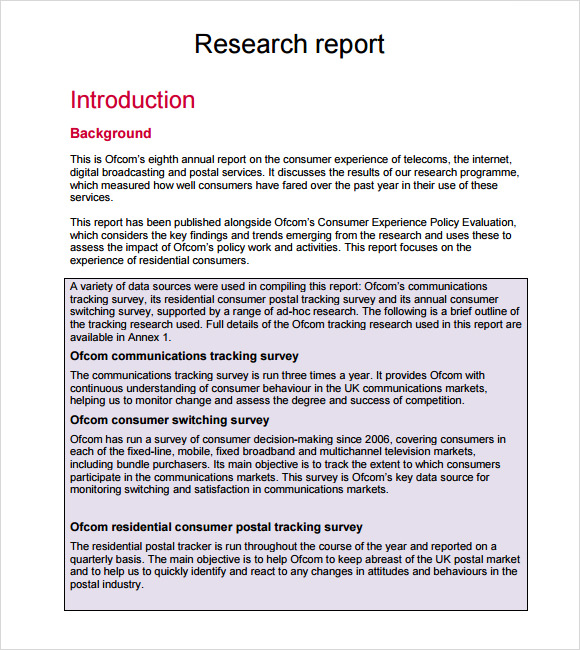
The free research report template shows a different format f writing your research paper. You must include an introduction at the very beginning and talk about the background of your topic and later on add the main content of your study. Download it right away!
Basic Research Report Template
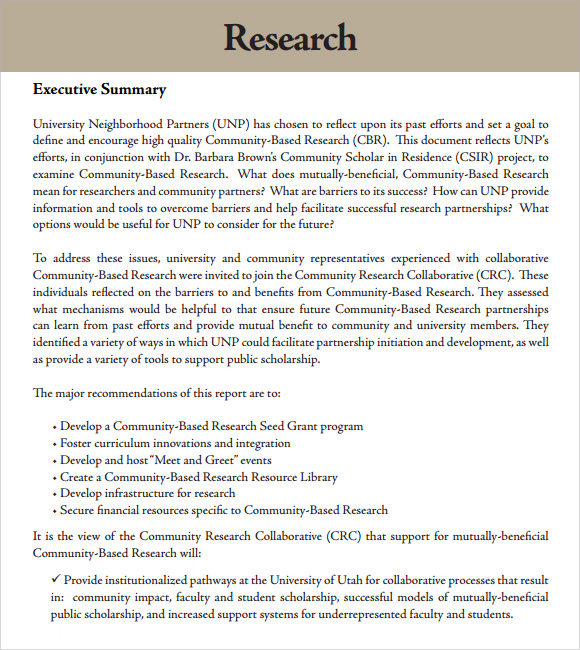
How to Write a Research Report?
- Start with a clear title and abstract summarizing the report.
- Introduce the research topic and its significance.
- Describe the research methods and data collection.
- Present the findings, analysis, and interpretation.
- Discuss the implications and relevance of the research.
- Conclude with a summary of key points and recommendations.
- Cite sources and include a bibliography.
- Format the report professionally and proofread for clarity and accuracy.
Simple Research Report Template

What are the Benefits of Research Report Samples?
Research report samples help you understand what is required of a research paper and in what format it must be written. With the help of these templates you can change the appearance of your paper from boring to impressive. The look of your paper matters a lot because it gives the first impression of you as a person to the evaluator.
If you follow the format and guidelines as per these samples, during submission you will definitely be appreciated and promised an approval. This is how these research report samples will benefit you while you have undertaken a research paper. You can also see Company Analysis Report Templates.
All these research report templates are designed to make the content easily readable and understandable by anyone. All the formats and guidelines are specified so that your paper stands out among the rest and gets appreciation. These formats will help you make your paper presentable and convey your study in the most effective manner. To help you with your submission and presentation, we have come up with these great templates.
Standard Research Report Template
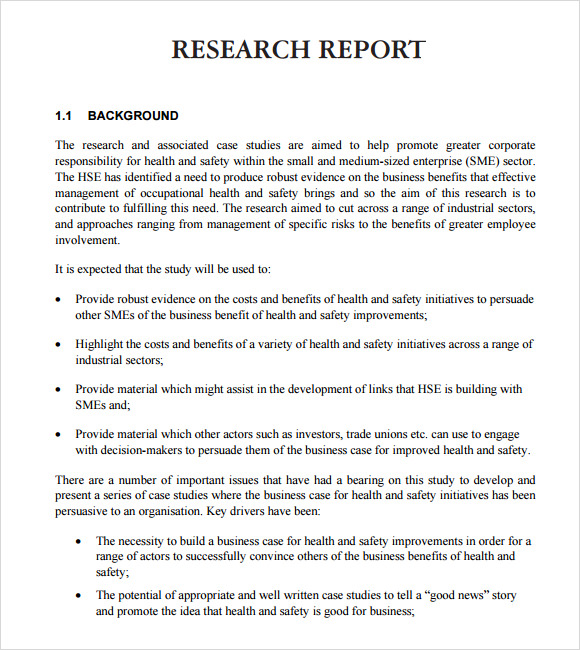
What is Formal Research Report?
A formal research report is a structured and detailed document that follows a specific format and style. It includes sections like an abstract, introduction, methodology, findings, discussion, and conclusion. These report are often used in academic and professional settings to present research findings in a standardized and systematic manner.
What is the Role of a Research Report?
The role of a research report is to communicate the results, analysis, and conclusions of a research study to inform and educate readers, such as researchers, policymakers, or the general public, about a specific topic or issue. It serves as a valuable resource for decision-making, further research, or reference in various fields.
When do you need Research Report?
A research report is needed when you want to communicate the findings of a systematic investigation. It serves to document, share, and disseminate research outcomes to various audiences, contributing to knowledge and decision-making.
What is research report title?
The research report title is a concise and descriptive phrase that provides an overview of the study’s focus. It should capture the essence of the research, guiding readers on its subject.
Why do you need Research Report Samples?
Research report samples are required so that you can refer to the method of writing a research paper. As per the rules and guidelines, all the research papers must be submitted in a specific way. Your papers will not be accepted if they are written in any manner.
In conclusion, the research report serves as a comprehensive documentation of a study’s findings and insights. It plays a crucial role in advancing knowledge and facilitating informed decision-making in various fields.
If you have any DMCA issues on this post, please contact us!
Related Posts
FREE 22+ Sample Training Plan Templates in Google Docs | MS Word | Pages | PDF
FREE 32+ Cost Analysis Samples in PDF | MS Word | Excel
FREE 10+ Stakeholder Analysis Samples in Google Docs | MS Word | Pages | PDF
FREE 11+ Sample Job Analysis Templates in Excel | Google Docs | MS Word | Pages | PDF
FREE 16+ Business Analysis Samples in MS Word | Google Docs | Pages
FREE 6+ Sample Printable Employee Handbook Templates in PDF | Google Docs | Pages | MS Word
FREE 13+ Policy and Procedure Templates in PDF
FREE 13+ Statement of Work Templates in Google Docs | MS Word | Pages | PDF
FREE 18+ Sample Price List Templates in PDF | MS Word | Pages | Google Docs | Google Sheets | Numbers | MS Excel | PSD | AI | Publisher
FREE 9+ Training Log Templates in PDF | MS Word
FREE 17+ Sample Downloadable Sales Agreement Templates in Google Docs | MS Word | Pages | PDF
FREE 13+ Sample Purchase Agreement Templates in PDF | MS Word | Pages
FREE 20+ Sample Buy Sell Agreement Templates in PDF | MS Word | Google Docs | Pages
FREE 18+ Sample Consignment Agreement Templates in Google Docs | MS Word | Pages | PDF
FREE 9+ Dvd Label Templates in PSD | MS Word
